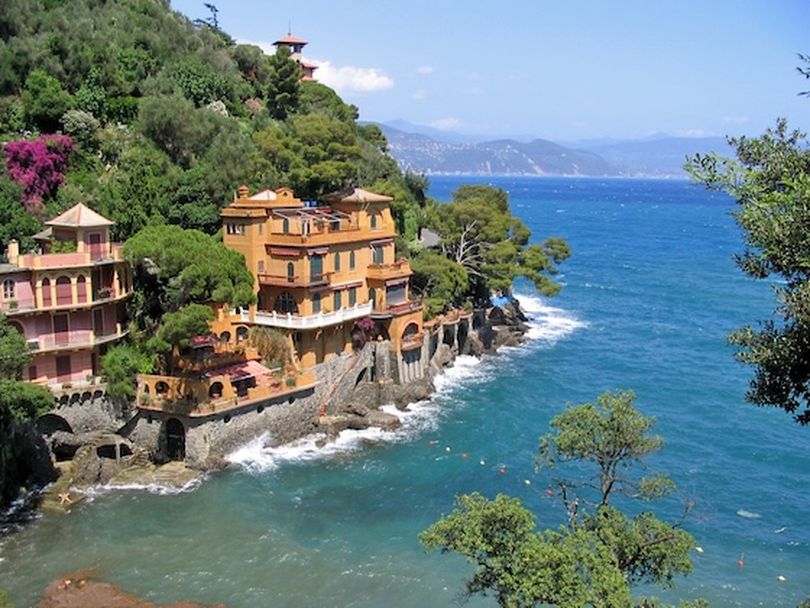Portofino: Where Italian stereotypes turn into dreams

Ah, Italy. On those occasional polls of must-see places, it typically ranks among the world’s Top 10. Maybe Top 5.
And that’s true not just among American travelers. In an Italian-language course I once took in Florence, the class was composed of students from all over the world, from the U.S. to Germany, Portugal to Japan.
Strangely enough, though, Italy typically is portrayed in a limited, stereotypical manner, at least in popular culture. Mostly it’s seen as a place where pasta-loving people either drive Vespas through the streets of Rome or sunbathe in skimpy suits on some sunny Mediterranean beach.
And they appear to do everything with a cigarette hanging from their lips while gesticulating wildly with their hands.
Go and rent Fellini’s “Amarcord” and you’ll see what I mean.
The truth about Italy is far more complicated. The country comprises 20 regions and is a collection of diverse areas, most with dialects distinct from standard Italian. The northern-most regions of the country, in fact, have more in common with Switzerland than anything connected with Rome, Naples or Palermo.
Friends of mine who for decades have lived part of the year in an apartment they own near Lake Como were the first ones who told me that there’s a common northern Italian saying: “There’s no life south of the Po.”
That may, or may not, be a joke, the Po being a river just 75 kilometers south of Milan. In any event, it certainly it isn’t a sentiment shared by anyone who lives in, or indeed has toured, southern Italy. But then we in the U.S. tend to joke about (enter the state of your choice here). So, who are we to judge?
I’ve been fortunate to have experienced all 20 regions, and while I don’t have any favorites, I do have favorite moments. One of the most memorable occurred a couple of decades ago in Portofino, a scenic village sitting on the Ligurian coast, some 35 kilometers from Genoa.
My wife Mary Pat Treuthart and I were staying in Santa Margherita Ligure, a village a little more than seven kilometers north of Portofino. Mary Pat and I were traveling with her sister and brother-in-law, Jean and Steve, and the four of us were trying – for once – to be budget-conscious. So, we chose to rent rooms in a bed-and-breakfast away from the far more affluent village that one website describes this way: “Europe’s rich and famous gather in Portofino, a village where humble fishing boats have been replaced by superyachts, and street markets by high-end designer boutiques.”
I can’t say that I enjoyed the place where we stayed. Our room felt more like a glorified storage closet than someplace designed for a comfortable sleep. And the manager, an officious British woman in her early 40s, acted more like a middle-school teacher keeping an eye on wayward students than someone accustomed to dealing with adults.
Every time I turned around she seemed to be standing there, ready to correct me for something I was about to do that, in her eyes, was wrong. One morning she chastised me in front of the breakfast crowd for picking up a newspaper that I’d found on a table and wanted to finish reading in our room. I sighed with relief after we departed.
But back to Portofino, getting there from Santa Margherita Ligure proved to be no problem. A taxi ride takes about six minutes, ferries make the run in 15 minutes, which is about the same time the bus takes. You could even walk the route in 90 minutes or so, depending on your fitness level. We chose the bus, which ran regularly and afforded us views of the many majestic mansions that line the coastal highway – one of which was reported to be owned by former Italian prime minister Silvio Berlusconi.
However you get there, the trip is worth it – if only to get a feel for how the super-rich live. We toured the small port, where we ate lunch in an outdoor restaurant with a view of the sea.
Afterward, we trekked to the world-famous, five-star hotel Splendido. A restored 16th-century monastery, the hillside establishment has played host to any number of celebrities – including, most famously, Elizabeth Taylor and Richard Burton, who are said to have stayed in rooms overlooking the port far below.
Not having access to Hollywood money, we didn’t stay there (more’s the pity). But we did have drinks in the garden. And that’s the moment I remember most fondly: Drinking a Bellini – which to my horror cost $15 – but enjoying both it and the Mediterranean sun immensely.
Sitting there and scrawling in my journal, I could ignore the fact that I would shortly have to return to Santa Margherita Ligure and put up with a B&B manager who boasted the soul of a Wicked Witch of the West.
That Bellini was expensive, especially all those years ago (it likely costs half again as much now). But it led to the kind of moment that dreams are made of
Italian dreams, anyway, free of cliché.
